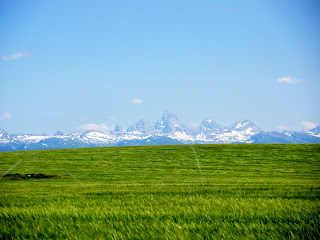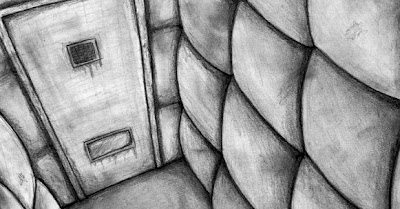The recent resurgence of Converse All-Stars as popular footwear must make some of those basketball players from the earlier part of the 20th Century roll their eyes. Old school and new school find a common sole. Chuck Taylor is smiling though, I tend to think, and the legend lives on via fad. One wonders when it will die and be resurrected again for whatever function. I prayed that bell bottoms had gone to the grave for good back in the ‘80’s, but we Americans with such shallow roots have to keep turning things over and over again (apparently, they go under the moniker of "boot cut" these days). In and out, and then back in again, a vicious cycle either determined by the arbitrary or the puppet masters. Either way, as far as I can tell, we’re like a stuttering Ferris wheel being operated by a drunk carnie.
But every now and then something really good comes along, something that we wish would stay. For instance, I’m a fan of Chuck Taylors. I hope Converse lives happily ever after. And as for those basketball players from an earlier generation, I can understand their sense of superiority. Whenever newbies go gaga over something that I experienced authentically a long time ago, I admit that it bothers me more than a little. I mean, no one actually plays basketball in them anymore. Posers, right?
So what’s the deal with bacon? Since I was knee high to a grasshopper I can remember having bacon and eggs for breakfast on a regular basis. And all the while growing up, I can’t remember anyone ever mentioning bacon other than taking what it is for granted. Sure, we all knew that consuming bacon was simply the guiltiest pleasure on earth. We all knew that it was the most prime meat, and that’s why we begged for it on the occasion it wasn’t on the breakfast menu.
Bacon was something to fight over. Chores were often traded for bacon. Frying pans and spatulas were licked for any remaining residue. Nobody wanted to brush their teeth after eating it. As kids, we didn’t give too much thought to getting married, buying a house, having kids, or having the perfect 8 to 5 job. No, we thought bacon was the American Dream. We assumed that bacon was the taste that every American kid took to school in his mouth.
Ever since I left home for college, my apartments or houses always carried the stench of stale bacon. Bacon grease was found splattered about the stove top most mornings and some evenings. My other cooking used bacon grease as an ingredient whenever I could plug it in, and it was used as fire starter in the wood stove. All of that couldn’t keep up with the amount of grease that I was able to produce on a weekly basis.
In other words, I am the authentic bacon fan. I was there before any big fuss was made over it. I have eaten bacon virtually since the time I was born, and I haven’t let up. So you can imagine my perplexed and jealous feeling. It was perplexing because I understood the enthusiasm behind the wave of sudden bacon enthusiasts, but I couldn’t understand why the sudden wave. Jealousy was born of the feeling that something long-standing and precious to me was being treated all of sudden like a cheap thrill.
This is all silliness, you say, and let the people just enjoy their bacon! Alright, I will, so onward with the bacon revolution. I surrender, but I still have a couple of beefs.
First, please learn how to cook bacon correctly. Bacon takes time. I am amazed, even in this era when bacon seems to be everywhere and all the rage, at the chances that I’m going to get poorly cooked bacon at a restaurant. More often than not people either burn bacon (which some people actually prefer to bacon cooked correctly) so that it turns into a pile of ashes in your mouth, or it is cooked just to the scant taste of ham with bad texture (curiously, some people like this sort of squishiness).
I know what you’re thinking – is this guy really a bacon nazi? – is cooking bacon really an objective thing? Maybe yes, and yes, respectively. There is an optimum point at which the fat has been rendered just enough to achieve the most desirable flavor that defines bacon itself. If you leave the poor bacon on past that optimum point, you will start getting the burnt flavor. That is because you are burning it. Burning things while cooking is usually a faux pas. But like I said, some people like their bacon burnt (probably because they don’t know any better). If someone requests that their bacon be extra crispy, you should reply with a lowered head, a furrowed brow and a slight shaking of the head. In this world, it is very possible that they haven’t had properly cooked bacon before.
On the other hand, undercooked bacon just doesn’t quite get you that bacon flavor that one should want. People who like their bacon squishy simply do not have a refined bacon palate, and if they request it that way, you should give them the aforementioned look.
The second beef is not unrelated. Bacon has been a staple of my diet, and the quality of my life has been the better for it. You don’t have the wiggle room in your veins for the extra cholesterol? Well, take it from me, it’s worth the extra exercise. It’s worth making the rest of your diet leaner. It’s worth getting your hands on any cholesterol lowering medication at any chance you get. Might as well grab the high blood pressure meds too.
More importantly, do it for your kids. Don’t allow the big bacon fad to fizzle out. Let’s all work together to ensure that bacon is taken for granted again. The revolution must mature. This is a cultural thing, folks, and it’s helpful for us to ponder on how we’ve gotten to this place in our bacon history.
Once upon a time people got up early enough to have the most important meal of the day. Eggs, bacon and hash browns were fried up before the family went to work and school. Everybody sat down and broke bread to start the day. But somewhere along the way we lost our heads, we started squishing out table time, and it took a toll both on the family relationships and the meal itself. Many families don’t eat at the same time these days, and the scrumptious breakfast was replaced by a bowl of cut up pieces of cardboard in skim milk.
Eating good food together is a building block of a good culture. Skim milk, fast food cereals and isolationist eating is not. So learn how to cook bacon correctly. Take the time to do it, and then take the time to eat it with one another. “Breaking bread” is the ultimate eating slogan, but “breaking bacon” with one another is a practice that I hope finds its permanence in a culture that needs some permanence.
~ J. Bunch













































